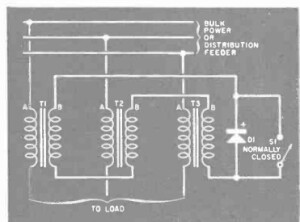 We’ve previously written about the NEAR system, which was a system envisioned to alert the American public to a nuclear attack. It relied upon a 240 Hz signal superimposed upon the power lines. This signal was picked up by an ingenious electromechanical receiver in the home, and sounded a loud buzzer in the event of an alert. We previously described how the receiver worked, and the August 1960 issue of Popular Electronics, from which the pictures above were taken, explains the equally simple method used to transmit the signal. In the schematic at right, at the utility substation, to send the alert, switch S1 is opened. The rectifier sends a flow of DC
We’ve previously written about the NEAR system, which was a system envisioned to alert the American public to a nuclear attack. It relied upon a 240 Hz signal superimposed upon the power lines. This signal was picked up by an ingenious electromechanical receiver in the home, and sounded a loud buzzer in the event of an alert. We previously described how the receiver worked, and the August 1960 issue of Popular Electronics, from which the pictures above were taken, explains the equally simple method used to transmit the signal. In the schematic at right, at the utility substation, to send the alert, switch S1 is opened. The rectifier sends a flow of DC pulses through the transformer secondaries, generating a signal at the fourth harmonic of the power line frequency. This signal averaged about 2-3 volts, meaning it would not interfere with regular power transmission.
pulses through the transformer secondaries, generating a signal at the fourth harmonic of the power line frequency. This signal averaged about 2-3 volts, meaning it would not interfere with regular power transmission.
On that October day, the alarm originated at a radar station in the Arctic, from which it was relayed to NORAD headquarters in Colorado Springs, CO. An officer there pushed the button to activate the NEAR system, resulting in the alarm being sounded almost immediately in Charlotte, MI.
That morning, seniors at the high school, the Charlotte Class of 1961, had inflated weather balloons and distributed them around town. When the devices buzzed in each home, homeowners were to release the balloon on a tether. Back at the courthouse, the students were in the tower of the courthouse counting balloons.
References
- Charlotte History: NEAR Testing
- Charlotte Republican-Tribune, Oct. 13, 1960
- Popular Electronics, Oct. 1961
